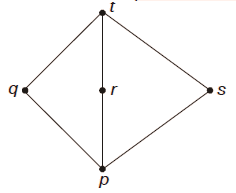Supongamos que L = {p, q, r, s, t} es una red representada por el siguiente diagrama de Hasse:
Para cualquier x, y ∈ L, no necesariamente distintas, x ∨ y yx ∧ y son unión y reunión de x, y respectivamente. Sea L 3 = {(x,y,z): x, y, z ∈ L} el conjunto de todos los tripletes ordenados de los elementos de L. Sea pr la probabilidad de que un elemento (x,y,z) ∈ L 3 elegido satisface equiprobablemente x ∨ (y ∧ z) = (x ∨ y) ∧ (x ∨ z). Entonces
(A) Pr = 0
(B) Pr = 1
(C) 0 < Pr ≤ 1/5
(D) 1/5 < Pr < 1
Respuesta: (D)
Explicación:
Number of triplets in L3 = Number of ways in which
we can choose 3 elements
from 5 with repetition
= 5 * 5 * 5
= 125.
Now, when we take x = t, then the given condition for L is
satisfied for any y and z. Here, y and z can be taken in
5 * 5 = 25 ways.
Take x = r, y = p, z = p. Here also, the given condition is
satisfied. So, pr > 25 / 125 > 1/5.
For x = q, y = r, z = s, the given condition is not satisfied
as q ⋁ (r ⋀ s) = q ⋁ p = q, while (q ⋁ r) ⋀ (q ⋁ s) = t ⋀ t = t.
So, pr ≠ 1.
Hence D choice.
Publicación traducida automáticamente
Artículo escrito por GeeksforGeeks-1 y traducido por Barcelona Geeks. The original can be accessed here. Licence: CCBY-SA
